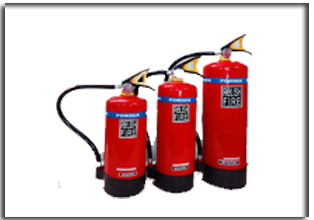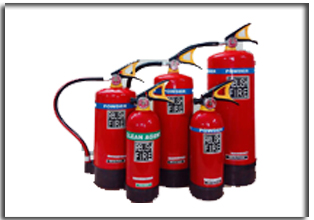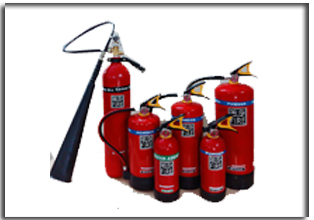ABC Fire Extinguishers
ABC Fire Extinguishers are very versatile Extinguisher in the world , They are often the ideal choice being that they are able to put out many different types of fires, They use Mono Ammonium Phosphate which is a dry chemical that is able to quickly put out the fire , It is a yellow powder that is able to put out all type classes of fire ; Class A for , wood , Fabric and paper , Class B for liquids Like Petrol , Kerosene and Diesel , and Class C for Gases Like LPG and CNG and energized electrical sources Like Electrical Fire . The Dry chemical smothers the fire , It can leave a residue once the fire has been put out when choosing this type of extinguisher.
Class A
Class A fires involve ordinary combustible materials, such as cloth , wood , paper , rubber , and many plastics . Extinguishers with an A rating are designed to extinguish fires involving these ordinary combustible materials.
Class B
Class B fires involve flammable and combustible liquids like Petrol , Diesel Kerosene , Alcohol , Oil-based paints , lacquers. Therefore, Extinguishers with a B rating are designed to extinguish fires involving flammable and combustible liquids .
Class C
Class C fires involve energized Gases Like CNG and LPG like equipment . Extinguishers with a C rating are designed for use with fires involving energized gases of Fire
Class E
Class E fires involve energized electrical equipment . Extinguishers with a E rating are designed for use with fires involving energized electrical equipment .
Mono ammonium phosphate , ABC Dry Chemical , DCP Powder , tri-class , or multi-purpose Dry chemical is a dry chemical extinguishing agent used on class A , class B , and class C fires . It uses a specially fluidized and silicon coated Mono Ammonium phosphate powder . ABC dry chemical is usually a mix of Mono Ammonium phosphate and ammonium sulfate , the former being the active one. The mix between the two agents is usually 40–60%, 60-40%, or 90-10% depending on local standards worldwide , The USGS uses a similar mixture , called like .
Chimney bombs are zip-lock bags or other small bags filled with ABC dry chemical powder . Chimney bombs are used by fire service personnel to help extinguish chimney fires , Creosote , which is the by-product of the incomplete burning of wood (typically due to chronic combustion-air insufficiency), is extinguished by the chain reaction caused by the chimney bombs , Chimney bombs work by first being dropped directly down a chimney , where upon contact with the flue bottom and heat of the fire , they explode , thereby releasing the powder . Then , the natural chimney draft will carry the dry chemical powder up the shaft of the chimney , thus coating the creosote and eventually neutralizing the fire , Use of multiple chimney bombs may be necessary , depending on how severe the fire is . Chimney bombs can also be effective if they are opened and then dropped down the chimney , In order for chimney bombs to be effective , it may be necessary to first unclog the chimney .
Ammonium sulfate precipitation is a common method for protein purification by precipitation . As the ionic strength of a solution increases , the solubility of proteins in that solution decreases . Ammonium sulfate is extremely soluble in water due to its ionic nature , therefore it can "salt out" proteins by precipitation , Due to the high dielectric constant of water , the dissociated salt ions being cationic ammonium and anionic sulfate are readily solvated within hydration shells of water molecules , The significance of this substance in the purification of compounds stems from its ability to become more so hydrated compared to relatively more no polar molecules and so the desirable non polar molecules coalesce and precipitate out of the solution in a concentrated form , This method is called salting out and necessitates the use of high salt concentrations that can reliably dissolve in the aqueous mixture . The percentage of the salt used is in comparison to the maximal concentration of the salt the mixture can dissolve . As such , although high concentrations are needed for the method to work adding an abundance of the salt , over 100% , can also oversaturated the solution therefore contaminating the non polar precipitate with salt precipitate . A high salt concentration , which can be achieved by adding or increasing the concentration of ammonium sulfate in a solution , enables protein separation based on a decrease in protein solubility ; this separation may be achieved by centrifugation , Precipitation by ammonium sulfate is a result of a reduction in solubility rather than protein denaturation , thus the precipitated protein can be solubilized through the use of standard buffers , Ammonium sulfate precipitation provides a convenient and simple means to fractionate complex protein mixtures .
In the analysis of rubber lattices , volatile fatty acids are analyzed by precipitating rubber with a 35% ammonium sulfate solution , which leaves a clear liquid from which volatile fatty acids are regenerated with sulfuric acid and then distilled with steam , Selective precipitation with ammonium sulfate , opposite to the usual precipitation technique which uses acetic acid , does not interfere with the determination of volatile fatty acids.






